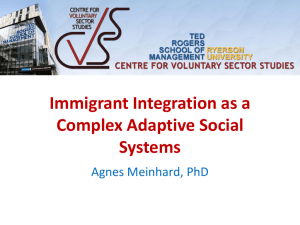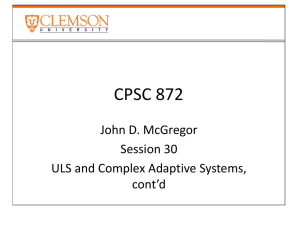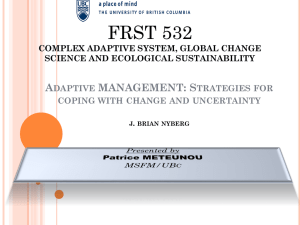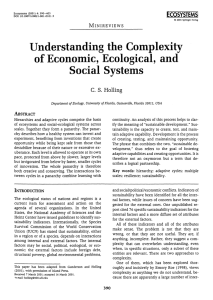Article_summary_Laur..
advertisement
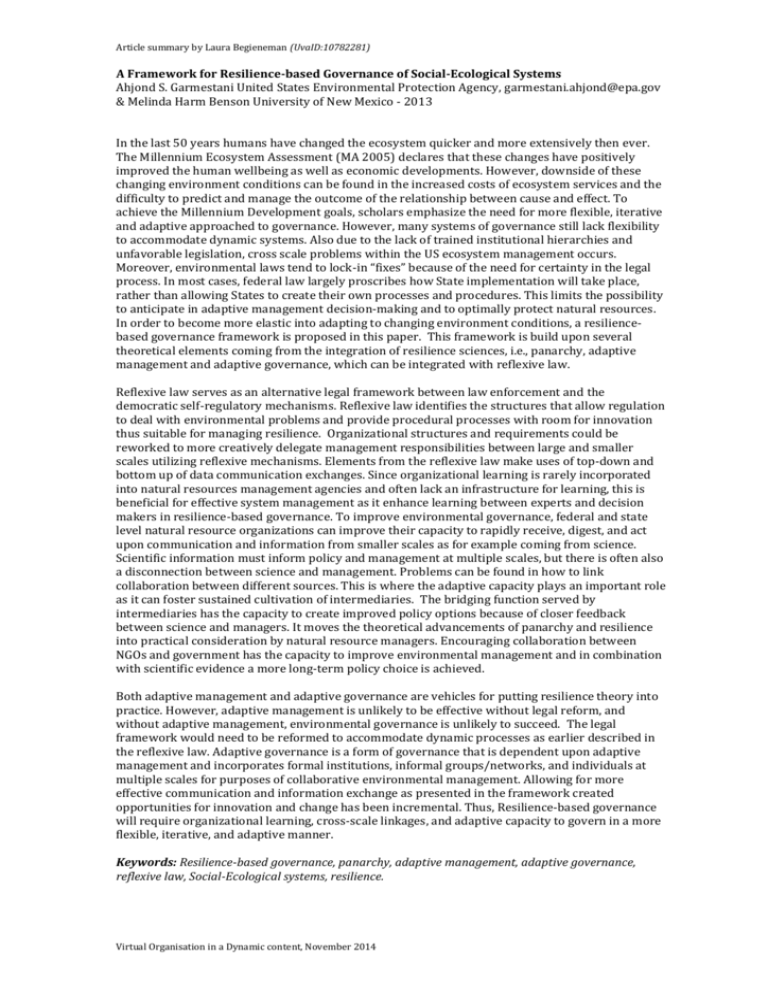
Article summary by Laura Begieneman (UvaID:10782281) A Framework for Resilience-based Governance of Social-Ecological Systems Ahjond S. Garmestani United States Environmental Protection Agency, garmestani.ahjond@epa.gov & Melinda Harm Benson University of New Mexico - 2013 In the last 50 years humans have changed the ecosystem quicker and more extensively then ever. The Millennium Ecosystem Assessment (MA 2005) declares that these changes have positively improved the human wellbeing as well as economic developments. However, downside of these changing environment conditions can be found in the increased costs of ecosystem services and the difficulty to predict and manage the outcome of the relationship between cause and effect. To achieve the Millennium Development goals, scholars emphasize the need for more flexible, iterative and adaptive approached to governance. However, many systems of governance still lack flexibility to accommodate dynamic systems. Also due to the lack of trained institutional hierarchies and unfavorable legislation, cross scale problems within the US ecosystem management occurs. Moreover, environmental laws tend to lock-in “fixes” because of the need for certainty in the legal process. In most cases, federal law largely proscribes how State implementation will take place, rather than allowing States to create their own processes and procedures. This limits the possibility to anticipate in adaptive management decision-making and to optimally protect natural resources. In order to become more elastic into adapting to changing environment conditions, a resiliencebased governance framework is proposed in this paper. This framework is build upon several theoretical elements coming from the integration of resilience sciences, i.e., panarchy, adaptive management and adaptive governance, which can be integrated with reflexive law. Reflexive law serves as an alternative legal framework between law enforcement and the democratic self-regulatory mechanisms. Reflexive law identifies the structures that allow regulation to deal with environmental problems and provide procedural processes with room for innovation thus suitable for managing resilience. Organizational structures and requirements could be reworked to more creatively delegate management responsibilities between large and smaller scales utilizing reflexive mechanisms. Elements from the reflexive law make uses of top-down and bottom up of data communication exchanges. Since organizational learning is rarely incorporated into natural resources management agencies and often lack an infrastructure for learning, this is beneficial for effective system management as it enhance learning between experts and decision makers in resilience-based governance. To improve environmental governance, federal and state level natural resource organizations can improve their capacity to rapidly receive, digest, and act upon communication and information from smaller scales as for example coming from science. Scientific information must inform policy and management at multiple scales, but there is often also a disconnection between science and management. Problems can be found in how to link collaboration between different sources. This is where the adaptive capacity plays an important role as it can foster sustained cultivation of intermediaries. The bridging function served by intermediaries has the capacity to create improved policy options because of closer feedback between science and managers. It moves the theoretical advancements of panarchy and resilience into practical consideration by natural resource managers. Encouraging collaboration between NGOs and government has the capacity to improve environmental management and in combination with scientific evidence a more long-term policy choice is achieved. Both adaptive management and adaptive governance are vehicles for putting resilience theory into practice. However, adaptive management is unlikely to be effective without legal reform, and without adaptive management, environmental governance is unlikely to succeed. The legal framework would need to be reformed to accommodate dynamic processes as earlier described in the reflexive law. Adaptive governance is a form of governance that is dependent upon adaptive management and incorporates formal institutions, informal groups/networks, and individuals at multiple scales for purposes of collaborative environmental management. Allowing for more effective communication and information exchange as presented in the framework created opportunities for innovation and change has been incremental. Thus, Resilience-based governance will require organizational learning, cross-scale linkages, and adaptive capacity to govern in a more flexible, iterative, and adaptive manner. Keywords: Resilience-based governance, panarchy, adaptive management, adaptive governance, reflexive law, Social-Ecological systems, resilience. Virtual Organisation in a Dynamic content, November 2014 Article summary by Laura Begieneman (UvaID:10782281) Reflection on the article The framework presented in the paper is buildup on theoretical elements coming from the integration of resilience sciences, i.e., panarchy, adaptive management and adaptive governance, which can be integrated with reflexive law. The central idea in the article is about how systems of governance can be adopted in order to react to the changing environmental condition with the aim to protect natural resources and become resilience. The changes are taking place in natural resource management and focus in the U.S in particular. This article is relevant to the theme that we study in this course because the adaptive cycle coming from of panarchy plays an important role in accommodating the changes described. Also the interactions between the different cycles in panarchy enables enhance continuously learning. Moreover, the panarchy theory helps to understand the changes that are transforming and are taking place in the systems that are adaptive. I describe how these changes are taking place according to my interpretation of the adaptive cycle and therefore the relevance of this article to the course. What could be said is that the article make uses of the four phases, which are identified in the cycle theory. These four dimensions are: 1. 2. 3. 4. Growth or exploitation Conservation Collapse or release Reorganization The adaptive cycle has two major phase the for and back loop. The first is slow phase of growth and accumulation. The second is the rapid phase of reorganization leading to renewal (Holling & Gunderson, 2002). Figure 1: Adaptive cycle of panarchy The fast changing growth dimensions are the humans who have changed the ecosystem quicker then ever before. The slow conversation dimension can be found in the governance systems. These systems are very static and can therefore not accommodate the changes, which is very problematic as the natural resource will be damaged or even worse get lost. This could actually be seen as the release dimension which is very vulnerable to change and will turn into a crises as it does not become resilience. This is also called the release phase. In order to overcome this new opportunities have to be created. Fostering communication and enhancing the learning capabilities of all different institutions involved in natural resource management such are governmental institutions, organizations, and universities, will do this. Also revising the different hierarchical layers enables a better and more flexible way of working. Another fundamental need is revision of the legal framework, which need to be reformed in order to accommodate dynamic processes. After collecting all the strategic option the reorganization can take place, which will lead to a new situation. The outcome will be a more resilience-based governance, which has an adaptive capacity to govern in a more flexible, iterative, and adaptive manner the changing environmental condition (Garmestani & Benson, 2013). This is an ongoing learning process and will time over time go through the same learning and adaptation phases, which enables the adaptive capability. References Garmestani, A. S., & Benson, M. H. (2013). A framework for resilience-based governance of socialecological systems. Ecology and Society, 18(1), 9. Holling, C. S., & Gunderson, L. H. (2002). Resilience and adaptive cycles.Panarchy: Understanding transformations in human and natural systems, 25-62. Virtual Organisation in a Dynamic content, November 2014




